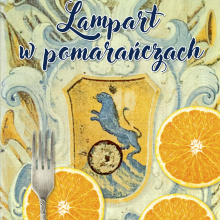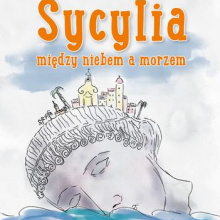Ewa Karolina Cichocka, a researcher of Polish-Sicilian artistic and literary relations, talks to Magdalena Nieczuja-Goniszewska about her new book Leopard in oranges. Sicilian culinary notes. Magdalena Nieczuja-Goniszewska discusses it.
- Leopard in oranges. Sicilian Culinary Notes is your third book about Sicily. This time, you were seduced by the culinary world, but as usual, you also reached for literature.
- This is true. This is the third time I have tackled the subject of the largest Mediterranean island. For the first time, I was fascinated by antiquity and the myths of Ancient Greece. I got to know the places where ancient stories happened, the ancient ruins, and I decided to write about them, illustrated by Ewa Niewadzi, a Sicilian by choice. The next book was a contemporary journey through the island, but also our literature. I was intrigued by the memories and works of our artists inspired by the Island of the Sun. So I decided to set off in their footsteps. The last of the books, which has just been published, is meant to appeal mainly to the senses of taste and sight. It tells stories about cuisine, cooking, tradition and a handful of simple recipes with a pinch of Polish and Sicilian literature.
- Why were you so interested in Sicilian cuisine?
- Sicilian cuisine was strongly influenced by the location and fate of the island. The development of its cuisine can be read like a book of Sicilian history. Situated between Europe and Africa, it was the place where Greek cuisine developed, and later, at the time of the invasions of the colonisers, it acquired the flavours of Arab or Spanish cuisine, and through it the flavours of the New World. Each of the nations that conquered Sicily - and there were many of them - left something behind - not only in art and architecture but also on the table. So Sicily is also in culinary terms a kind of melting pot and a mixture of cultures. This makes it very interesting, original and different.
- Your book is a journey through cities, towns and villages. Meetings at the markets, the oil mill, the vineyard or the fisherman's harbour. But you also find yourself in a palace kitchen and on a film set.
- This book is a description of my culinary encounters from many journeys, during which I found myself in various places. Obvious ones, like markets and trattorie, but also unusual ones, like tonnars - former tuna fishing and processing places or a ceramics workshop and a set of a costume film in Palermo. I have divided the book into several chapters in which the stories are linked by a common theme. So there is a journey to ancient Greece and a look at the flavours of yesteryear, looking for them in today's menus. There are also memories of villages, small processing plants, vineyards and orchards. There is also a site dedicated to markets and street food, which is still original and very popular. I really like these places, covered in patina, which have a lot of authenticity and atmosphere, unfortunately also changing under the influence of tourism, which I also mention. I have devoted a separate place to mafia cuisine, which smells of sensation. Here, too, I turn to literature, which may come as a pleasant surprise to fans of Camilleri's works and the adventures of commissioner Montalbano. I also look into a mafia cookbook or the open-air locations from the making of the Godfather films. I also go to palaces to look at aristocratic cuisine.
- Each chapter of your book is divided into three parts. There are stories about culinary adventures, but also evocative photographs and recipes.
- This was my idea, to appeal to different senses of the reader. It is obvious that there are recipes because the book is about cooking, photos because you eat with your eyes. And the stories seemed to me to be a necessary storytelling, giving an aura to flavours and places. So you will be able to read, watch, and then prepare and taste something yourself. I hope that this idea will appeal to readers and to... taste.
- Is Sicilian cuisine complicated? Does it require special and hard to find ingredients?
- I focused on recipes that are surprising and not obvious to us, and above all, very simple. For me, Sicily is a land of wonderful holidays, and all the recipes are a way to prepare a summer meal very simply and quickly in a summer kitchen on the terrace. Anyway, Sicilian cuisine is simple, often poor, using cheap ingredients. The dish can even be bread with oil. This is how a meal in a restaurant sometimes starts, except that the bread is straight from the oven and with sesame seeds, and the oil is of the highest quality. But the surprise can be oranges with onions and olives, raisins in cauliflower sauce with pasta, or almonds as an accompaniment to fish... Of course, some products will be difficult to find in our country, such as squid sepia, fresh octopus or sheep ricotta. But there are many whose use will evoke the Sicilian climate and taste. Fresh fish, seafood and hearty vegetables are healthy and light cuisine, requiring no special spices or skills. Simplicity and nature.
- In your book, you also write about aristocratic tables and visit the duchess and baron in real palaces.
- The rustic cuisine was once contrasted with the exquisite cuisine of the rich lords' tables. In Sicily, descendants of former aristocratic families still live in some palaces today. There, the cuisine was obviously richer and more refined with French influences. Following the culinary and literary trail through Sicily, I also found myself in the palace kitchen of the Duchess, who today holds culinary courses in the centuries-old interiors. It is an unusual place because of the history of tastes and products, but also because of its connection with literature. In fact, in Palermo, Princess Nicoletta Polo Lanza di Tomassi organises workshops in the palace of her foster father-in-law, the writer Giuseppe Tamassi di Lapedusa, author of the famous Leopard. So my visit was not only a gourmet experience but also an encounter with the writer's memorabilia, book collection and manuscript. Entering the theme of the old palace kitchen, I reached for the extraordinary descriptions of dishes and tables, the times of the old aristocracy, whose passing was described by the author of The Leopard.
- A visit to the palace can sometimes be an unexpected encounter and a link between history and modernity. During which visit did you come across traces of a Polish traveller and writer from 180 years ago?
- The figure of Michał Wiszniewski appeared quite unexpectedly at Palazzo Biscari in Catania during my conversation with Baron Ruggiero Moncada di Paterno about cuisine and the people who visited his palace, including Goethe, Szymborska, and Zanussi. The Baron showed me the guest book, which the family has kept for hundreds of years. To my surprise, I found in it the autograph of Wiszniewski, who had visited the Baron's great, great, great grandfather in 1845. I knew this fact from his Sicilian memoirs, but seeing the authentic entry, the continuity and cultivation of the Biscari family's tradition of hospitality - unchanged for two centuries - made a huge impression on me. I was also a traveller and a guest from Poland who was welcomed in the same palace, in the same family after 180 years. Wiszniewski described the visit and I described my stay. A shiver ran down my spine...
- Michal Wiszniewski isn't the only one of our authors whose travel memoirs you reach for. Who else has written about the flavours of Sicily?
- The origins go back to the 17th century when the island was visited by Jan Andrzej Morsztyn, who, apparently enchanted, recalled the exquisite flavours of the drinks he drank on the island. But I also recall the visits and experiences of Adam Mickiewicz, Michał Borch, Julian Ursyn Niemcewicz, Jarosław Iwaszkiewicz, Karol Szymanowski and Roman Brandstaetter. Among their recollections were also wine excesses. I also recall the culinary episodes of contemporary visitors fascinated by the island - Jerzy Stuhr and Krzysztof Zanussi. These are probably obvious proofs that this cuisine and Sicilian taste have made and continue to make unforgettable impressions and remain not only in memory but also in literature.
- You have already held many meetings and exhibitions dedicated to Sicily. You have also participated in scientific conferences related to this topic. And now you will share your Sicilian memories with the students of the University of the Third Age at UG in the winter semester of the next academic year.
- I really enjoy meetings with the public. Not only are they just nice, but I'm always surprised that so many people bother to talk about Sicily. The consequences of many of them are extraordinary meetings, conversations and even friendships. I sometimes learn something I didn't know about the island. I am very much looking forward to these meetings at GUTW. They were already planned and unfortunately postponed because of the pandemic. I was very keen for the listeners to be able not only to see Sicily on the screen, listen to stories but also to taste and add something from their own experiences. That's why I'm waiting for the classes to start in the autumn in real life. I'm planning meetings devoted to the wild nature of volcanic islands, antiquity, wandering in the footsteps of Polish artists and, of course, Sicilian cuisine.
- Thank you for the interview.
Ewa Karolina Cichocka - journalist, traveller, organiser and guide of women's expeditions with the Marek Kamiński Foundation. For years, she has been researching Sicily and Polish-Sicilian artistic and literary relations. She has published three books about Sicily; the UG Main Library hosted an exhibition of her travel and literary fascination with Sicily. Since January 2021, she has been a journalist in the Press Team of the University of Gdańsk.


